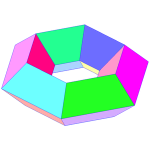Cellular objects: CW complexes
Wednesday, November 14th, 2012 | Author: Konrad Voelkel
We will investigate the notion of cellular objects in a model category; today: the classical case of CW-complexes in the model category of topological spaces with Serre-fibrations as fibrations.
A CW complex is a certain kind of topological space, together with a CW structure, which is a description how to glue the space from spheres (or from affine spaces, if you prefer), called the cells. The acronym CW stands for "closure finite, weak topology", which I will explain soon. CW complexes are a class of spaces broader than simplicial complexes, and they are still combinatorial in nature.
You can read definitions in the Wikipedia, I will only present the inductive definition here:
A CW complex  consists of n-skeleta
consists of n-skeleta  which are Hausdorff topological spaces, together with attaching maps in each degree n, that are maps
which are Hausdorff topological spaces, together with attaching maps in each degree n, that are maps  indexed by $i \in I_n$, such that
indexed by $i \in I_n$, such that  . By definition,
. By definition,  and
and  .
.
The map  describes how to attach an affine space (the "cell") of dimension
describes how to attach an affine space (the "cell") of dimension  , considered as unit ball
, considered as unit ball  , along its boundary
, along its boundary  to the space
to the space  .
.
The direct limit over all these skeleta carries the weak topology with respect to all the characteristic maps  which are the extensions of
which are the extensions of  to the attached inner of the cell. We denote this direct limit by
to the attached inner of the cell. We denote this direct limit by  again.
again.
This is also where you can see "weak topology" and "closure finite", the latter means that a set is closed if its intersection with all skeleta is closed, a property of the direct limit topology.
To avoid some confusion: Such a space  is just a topological space of CW type (= admits a CW structure), whereas the collection of all the skeleta and attaching maps are the CW structure that turns
is just a topological space of CW type (= admits a CW structure), whereas the collection of all the skeleta and attaching maps are the CW structure that turns  into a CW complex. There can be different CW structures on the same space, for example the n-sphere can be built from a 0-cell (basepoint) and an n-cell, but one can also introduce intermediate cells from any intermediate sphere.
into a CW complex. There can be different CW structures on the same space, for example the n-sphere can be built from a 0-cell (basepoint) and an n-cell, but one can also introduce intermediate cells from any intermediate sphere.
Some examples where you should be able to come up with CW structures: Tori (possible with a 0-cell, two 1-cells and a 2-cell), projective space (there the attaching map is more interesting), Grassmannians (the famous Schubert cells can be used).
For homotopy theoretic purposes, one can study spaces which may not admit a CW structure, but are homotopy equivalent to a space of CW type. These spaces are called of CW homotopy type, and a prominent example are all smooth manifolds. It is also good to know that all spaces have the weak homotopy type of a CW complex, i.e. every space admits a map to a CW complex such that the map induces isomorphisms on all homotopy groups.
From a CW structure for a space  , one can compute the homology and cohomology combinatorically. This is very similar to the Euler identity for planar graphs, that states Edges-Vertices+Faces = Euler-Characteristics (planar graphs are examples of CW complexes).
, one can compute the homology and cohomology combinatorically. This is very similar to the Euler identity for planar graphs, that states Edges-Vertices+Faces = Euler-Characteristics (planar graphs are examples of CW complexes).
